Tomb of the Unknown Soldier

A Tomb of the Unknown Soldier refers to a monument in dedication to the services of an unknown soldier and to the common memories of all soldiers killed in any war. Such tombs can be found in many nations and are usually high-profile national monuments. Throughout history, many soldiers have died in war with their remains being unidentified. Following World War I, a movement arose to commemorate these soldiers with a single tomb, containing the body of one such unidentified soldier.
History
Britain and France
During the First World War, the British and French armies who were allies during the war jointly decided to bury soldiers themselves. In Britain, under the Imperial War Graves Commission (now Commonwealth War Graves Commission), the Reverend David Railton had seen a grave marked by a rough cross while serving in the British Army as a chaplain on the Western Front, which bore the pencil-written legend "An Unknown British Soldier".[1] He suggested (together with the French in their own country) the creation at a national level of a symbolic funeral and burial of an "Unknown Warrior", proposing that the grave should in Britain include a national monument in the form of what is usually, but not in this particular case, a headstone. The idea received the support of the Dean of Westminster, Prime Minister David Lloyd George, and later from King George V, responding to a wave of public support.[1] At the same time, there was a similar undertaking in France, where the idea was debated and agreed upon in Parliament.
Britain and France conducted services connected with their 'monumental' graves (as presumably newly conceived, and in any case approved, by their respective armies) on Armistice Day 1920 (the burial itself taking place later in January of the following year in France). In Britain, the Tomb of the Unknown Warrior was created at Westminster Abbey, while in France La tombe du soldat inconnu was placed in the Arc de Triomphe.
Other countries
The idea of a symbolic Tomb of the Unknown Soldier then spread to other countries. In 1921, the Tomb of the Unknowns (United States), Tomb of the Unknown Soldier (Portugal) and Monument to Vittorio Emanuele—Unknown Soldier (Italy) were all unveiled. Other nations have followed the practice and created their own tombs.
In the United States and other countries, tombs have also been created representing the fallen of other wars in their history. In Chile and Ukraine, second 'unknown tombs' were unveiled to commemorate The Unknown Sailor.
Symbolism
The Tombs of the Unknown Soldiers typically contain the remains of a dead soldier who is unidentified (or "known but to God" as the stone is sometimes inscribed).[2] The remains are considered impossible to be identified, and so serve as a symbol for all of a country's unknown dead wherever they fell in the war being remembered. The anonymity of the entombed soldier is the key symbolism of the monument; it could be the tomb of anyone who fell in service of the nation, and therefore serves as a monument symbolizing all of the sacrifices.
Examples
Tombs of the Unknown Soldier from around the world and various wars include:
| Countries | Location | Image | Description |
|---|---|---|---|
| Argentina | Metropolitan Cathedral in Buenos Aires |  |
Tomb of the Unknown Soldier of the Independence |
| Australia | Australian War Memorial in Canberra | .jpg) |
The tomb of the Unknown Australian Soldier at the Australian War Memorial in Canberra. |
| Austria | Heldenplatz in Vienna | .jpg) |
|
| Bangladesh | Jatiyo Smriti Soudho in Savar Upazila | 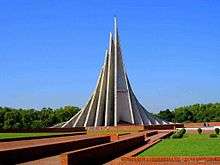 |
Jatiyo Sriti Shoudho (Bengali: জাতীয় স্মৃতি সৌধ Jatio Sriti Shoudho) or National Martyrs' Memorial is the national monument of Bangladesh is the symbol in the memory of the valour and the sacrifice of all those who gave their lives in the Bangladesh Liberation War of 1971, many of whom were buried in mass graves in that park.The monument is located in Savar, about 35 km north-west of the capital, Dhaka. It was designed by Syed Mainul Hossain. |
| Shikha Onirban or 'Eaternal Flame' in Dhaka | Shikha Onirban was built to commemorate the valour and the sacrifices of Bangladesh Armed Forces Soldiers died In the Bangladesh Liberation War in 1971. | ||
| Belgium | Congress Column in Brussels | |
The Tomb of the Unknown Soldier at the base of the location. |
| Bolivia | Monumento al Soldado Desconocido in La Paz | The Tomb of the Unknown Soldier, center piece of the location. | |
| Brazil | Monument to the dead of World War II, Flamengo Park in Rio de Janeiro. | 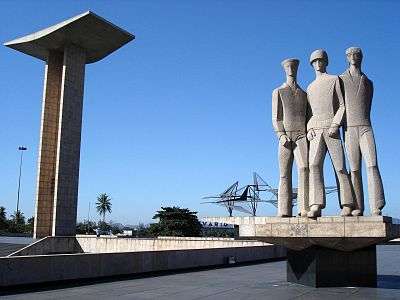 |
The Tomb of the Unknown Soldier on the monument's platform. |
| Brazilian Monument and Tomb of the Unknown Soldier of World War II, near Pistoia, Italy. | 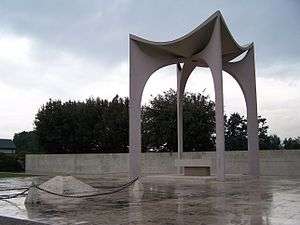 |
Votive Tomb of the Unknown Soldier, with monument pavilion. | |
| Bulgaria | Monument to the Unknown Soldier in Sofia |  |
|
| Monument to the Unknown Soldier in Haskovo. | |||
| Canada | Tomb of the Unknown Soldier at the National War Memorial, Confederation Square in Ottawa |  |
[3] |
| Chile | General Manuel Baquedano Square in Santiago | Contains the remains of a soldier who died in 1881 during the War of the Pacific. | |
| Plaza de la Ciudadanía (Citizenship Square), Santiago | Contains the remains of a soldier found in Perú. Died in 1881 during the War of the Pacific. | ||
| Cripta del Morro de Arica (Rock of Arica Crypt), Arica | Contains the remains of a soldier found in 1998. Died during the War of the Pacific. | ||
| Unknown Sailor Monument | A monument built in honor to the sailors that fought and died in the Battle of Iquique, a naval battle off the coast of Chile. | ||
| Czech Republic | National Monument on Vítkov Hill in Prague | |
contains remains of an unknown Czech soldier fallen at the Battle of Zborov as well as an unknown Czechoslovak soldier fallen at the Battle of Dukla (1944), a part of a larger memorial to all Czechoslovak soldiers. |
| Dominican Republic | Flag Square of Santo Domingo |  |
The Arc of the Square contains the tomb of the soldier who died for the freedom of the Dominicans in the Dominican War of Independence. |
| Egypt | Unknown Soldier Memorial in Cairo | 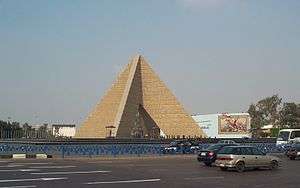 |
Also includes the tomb of President Anwar Sadat. |
| Alexandria Naval Unknown Soldier Memorial | .jpg) |
||
| Estonia | Defence Forces Cemetery in Tallinn | ||
| Finland | Hietaniemi cemetery in Helsinki | |
In the centre of the military cemetery are the tombs of the unknown soldier and Marshal Carl Gustaf Emil Mannerheim. |
| France | Tomb of the Unknown Soldier beneath the Arc de Triomphe de l'Étoile in Paris |  |
|
| Germany | Unter den Linden, Berlin |  |
Within a 19th-century guardhouse, the Neue Wache. |
| Greece | Tomb of the Unknown Soldier on Syntagma Square in Athens | |
|
| Hungary | Heroes' Square in Budapest |  |
|
| India | India Gate, New Delhi | |
Burning in a shrine under the arch of India Gate since 1971 is the Amar Jawan Jyoti (the flame of the immortal soldier) which marks the Tomb of the Unknown Soldier. The shrine itself is a black marble cenotaph with a rifle placed on its barrel, crested by a soldier's helmet. Each face of the cenotaph has inscribed in gold the words "Amar Jawan" (Immortal Warrior) in Hindi (Devanagri script). The Prime Minister of India pays homage to the country's fallen soldiers along with the Chiefs of Staff of each arm of the Armed Forces on each Republic Day of India. |
| Indonesia | The Pandu war cemetery at Bandung |  |
The Field of Honor is a memorial to the unknown soldier. There is also the Tomb of the Unknown (Dutch) Sailor in Kembang Kuning war cemetery in Surabaya.[6] |
| Iran | Chizar, Tehran |  |
In Iran, unknown soldiers are buried in public places. Chizar is the largest of all. |
| Behesht Zahra, Tehran |  |
||
| Iraq | The Monument to the Unknown Soldier, Baghdad | ||
| Israel | Garden of the Missing in Action in Mount Herzl, Jerusalem | |
Initially called the "Unknown Soldier Monument", the garden commemorates IDF soldiers whose burial place is unknown. A National Memorial Hall featuring a new memorial to the Unknown Soldier is scheduled to open nearby in 2015. |
| Italy | Piazza Venezia in Rome |  |
The Tomb of the Milite Ignoto in the Altare della Patria (Vittoriano). |
| Japan | Chidorigafuchi National Cemetery in Tokyo |  |
|
| Ryozen Kannon in Kyoto |  |
||
| Tomb of the Unknown Soldier of the World in Ogose, Saitama | |||
| Dai Heiwa Kinen Tō in Tondabayashi, Osaka |  |
||
| Lebanon | Tomb of the Unknown Soldier in Lebanon, Beirut, Mathaf | The Tomb of the Unknown Soldier in Lebanon represents the forming and independence of the Lebanese Armed Forces from the French Army in 1943.[7] The tomb also commemorates soldiers of the Legion of Orient[8] and the Army of the Levant during the French Mandate of Lebanon from 1920 to 1943.[7] The cenotaph in the middle includes a Cedrus libani tree surrounded by a laurel; the main symbol of Roman Legions. Around the cedar tree and laurel reads in Arabic : "Glory and Immortality for our Martyred Heroes". Behind the cenotaph are original Roman Columns. | |
| Lithuania | Vienybės Square in Kaunas |  |
Tomb of Nežinomas kareivis, with remains of soldier who died in fights against Bolsheviks in 1919. |
| Malaysia | National Monument in Kuala Lumpur |  |
Completed in 1966 to commemorate combatants who fought against Japanese occupation of pre-independence Malaysia in World War II and the Malayan Races Liberation Army insurgency during the Malayan Emergency. Also includes a pre-independence cenotaph, which was shifted from its original location closer to the old town of Kuala Lumpur, commemorating the war dead of World War I, World War II and the Malayan Emergency. |
| Namibia | Heroes' Acre in Windhoek | The Tomb of the Unknown Soldier contains soil from Cassinga and Oshatotwa from the Namibian War of Independence. | |
| New Zealand | Tomb of the Unknown Warrior, National War Memorial in Wellington | |
|
| Peru | Plaza Bolivar in Lima | |
Contains the remains of a soldier who died in 1881 during the War of the Pacific. |
| Philippines | Heroes' Cemetery in Taguig |  |
Contains the remains of Filipino soldiers who have joined the military and served on the Philippine Revolution, Philippine–American War and World War II. |
| Shrine of Valour in Bataan |  |
Contains the remains of the valiant Filipino and American soldiers who had fallen in the Battle of Bataan during World War II. | |
| Poland | Tomb of the Unknown Soldier, Marshall Józef Piłsudski Square in Warsaw |  |
Constructed as the arcade of Saxon Palace, which was destroyed by Germans in 1944. Contains the remains of a soldier who died between 1918 and 1920. |
| Portugal | Tomb of the Unknown Soldier in the Batalha Monastery | .jpg) |
|
| Romania | Tomb of the Unknown Soldier, Carol Park in Bucharest |  |
|
| Russia | Tomb of the Unknown Soldier, Alexander Garden in Moscow |  |
|
| Serbia | Monument to the Unknown Hero on Mt. Avala near Belgrade |  |
|
| Slovenia | Monument to the Unknown French Soldier, French Revolution Square in Ljubljana | ||
| Somalia | Tomb of the Unknown Soldier, Mogadishu | 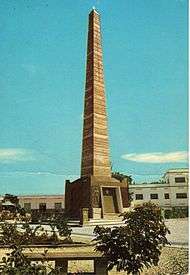 |
A monument erected in honour of the Somali men and women who died in defense of the Somali Republic. It's popularly known as Daljirka Dahsoon, and it is an important landmark in Mogadishu. |
| Spain | Monumento a los Caídos por España, Plaza de la Lealtad in Madrid | _01.jpg) |
Popularly known as the Obelisco ("Obelisk"), it is built on the same place where General Joachim Murat ordered the execution of numerous Spaniards after the Dos de Mayo Uprising of 1808. Originally inaugurated on May 2, 1840, it was re-inaugurated on November 22, 1985, by Juan Carlos I of Spain as a remembrance to all those who gave their life for Spain. An eternal flame fuelled by gas has been constantly burning on the front of the monument. |
| Fossar de les Moreres, in Barcelona | |
The Fossar de les Moreres is a memorial plaza in Barcelona (Catalonia, Spain), adjacent to the basilica of Santa Maria del Mar. The plaza was built over a cemetery where defenders of the city were buried following the Siege of Barcelona at the end of the War of the Spanish Succession in 1714. The plaza retains its everyday use as a public space, but also prominently features a memorial to the fallen Catalans of the war, with a torch of eternal flame and a heroic poem by Frederic Soler, "El Fossar de les Moreres". | |
| Syria | Tomb of the Unknown Soldier in Damascus | ||
| Turkey | Çanakkale Martyrs' Memorial on Gallipoli | |
Erected for the unknown martyrs of the Çanakkale Front, which was the arena for the Battle of Gallipoli during World War I. Opened on 20 August 1960. Another monument at the same site is for the foreign soldiers (mostly Australian and New Zealand Army Corps) lost in the same clash. |
| Ukraine | Tomb of the Unknown Soldier, Dnieper Park in Kiev |  |
|
| Monument to the Unknown Sailor, Shevchenko Park in Odessa |  |
||
| United Kingdom | Tomb of the Unknown Warrior, Westminster Abbey in London |  |
|
| United States | Tomb of the Unknowns, Arlington National Cemetery in Arlington, Virginia |  |
The Tomb of the Unknown Soldier at Arlington National Cemetery stands atop a hill overlooking Washington, D.C.. On March 4, 1921, Congress approved the burial of an unidentified American soldier from World War I in the plaza of the new Memorial Amphitheater.
The white marble sarcophagus has a flat-faced form and is relieved at the corners and along the sides by neo-classic pilasters, or columns, set into the surface. Sculpted into the east panel which faces Washington, D.C., are three Greek figures representing Peace, Victory, and Valor. The six wreaths, three sculpted on each side, represent the six major campaigns of World War I. Inscribed on the back of the Tomb are the words: Here rests in honored glory an American soldier known but to God The Tomb sarcophagus was placed above the grave of the Unknown Soldier of World War I. West of the World War I Unknown are the crypts of unknowns from World War II and Korea, plus one empty crypt honoring missing service members from all conflicts. Those three graves are marked with white marble slabs flush with the plaza. The empty crypt originally held the remains of an unknown from the Vietnam War, but its occupant was identified in 1998 and his remains returned to his family for burial in St. Louis. |
| Tomb of the Unknown Revolutionary War Soldier, Washington Square in Philadelphia | 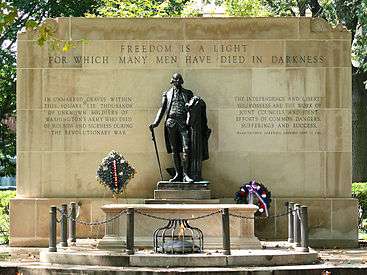 |
||
| Civil War Unknowns Monument, Arlington National Cemetery in Arlington, Virginia | |
Contains the remains of 2,211 unknown Union and Confederate soldiers from Civil War battlefields. | |
| Tomb of the Unknown Confederate Soldier at Beauvoir in Biloxi, Mississippi | 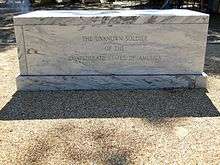 |
||
| Venezuela | Tomb of the Unknown Soldier on Carabobo Field, Carabobo | Contains the remains of a Venezuelan soldier who died in 1824 during the Battle of Ayacucho. | |
| Zimbabwe | Statue of the Unknown Soldier at the National Heroes Acre, Harare |  |
|
See also
References
- 1 2 Henry Allingham, Dennis Goodwin (2011). "Kitchener's Last Volunteer: The Life of Henry Allingham, the Oldest Surviving Veteran of the Great War". p. 132. Random House, 1976
- ↑ Kwon, Heonik (2008). Ghosts of War in Vietnam. Cambridge University Press. p. 46. ISBN 0-521-88061-0.
- ↑ "National War Memorial". ottawakiosk.com. Retrieved April 21, 2015.
- ↑ Thucydides (1942). "2.34.3". Historiae in two volumes. Oxford: Oxford University Press. Available online at the Perseus Project.
- ↑ Thucydides (1942). "2.43.3". Historiae in two volumes. Oxford: Oxford University Press. Available online at the Perseus Project.
- ↑ "Netherlands war cemeteries in Indonesia", Netherlands War Graves Foundation
- 1 2 "Lebanese Ground Forces". GlobalSecurity.org. Retrieved December 8, 2008.
- ↑ "LAF History". Lebanese Armed Forces. Retrieved 2009-05-19.
External links
| Wikimedia Commons has media related to Unknown Soldier. |
- Copernicus Organization, World Veterans Federation, "Tombs of the Unknown Soldier in Central and Eastern Europe" by Prof. Michał Chilczuk, Chairman, Working Group on Central and Eastern Europe, SCEA
- Vivaboo.com, "Tomb Of The Unknown Soldier Around The World (History)"